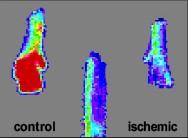Critical hindlimb ischemia and endothelial dysfunction
Role of endothelial cell dysfunction in the pathophysiology of critical limb ischemia
 Therapeutic angiogenesis for ischemic diseases, including critical limb ischemia (CLI), was proposed as a supplement or alternative to surgical revascularization. Nevertheless, after promising results obtained in animals, it failed to demonstrate any significant effect in large human clinical trials. Our objective is to explore the pathophysiological mechanisms associated with impaired tissue repair and perfusion in patients with CLI with the aim to identify new therapeutic targets.
Therapeutic angiogenesis for ischemic diseases, including critical limb ischemia (CLI), was proposed as a supplement or alternative to surgical revascularization. Nevertheless, after promising results obtained in animals, it failed to demonstrate any significant effect in large human clinical trials. Our objective is to explore the pathophysiological mechanisms associated with impaired tissue repair and perfusion in patients with CLI with the aim to identify new therapeutic targets.
 We hypothesized that endothelial dysfunction caused by cardiovascular risk factors including diabetes rather than reduced capillary density might be responsible for impaired tissue perfusion in the setting of CLI. To test our hypothesis, we have developed a mice model of chronic limb ischemia in diabetic mice.
We hypothesized that endothelial dysfunction caused by cardiovascular risk factors including diabetes rather than reduced capillary density might be responsible for impaired tissue perfusion in the setting of CLI. To test our hypothesis, we have developed a mice model of chronic limb ischemia in diabetic mice.
By the meantime, we are exploring the role of the Hedgehog signaling in maintaining endothelial proper function and test the therapeutic potential of targeting endothelial cell dysfunction by manipulating Hedgehog signaling.
